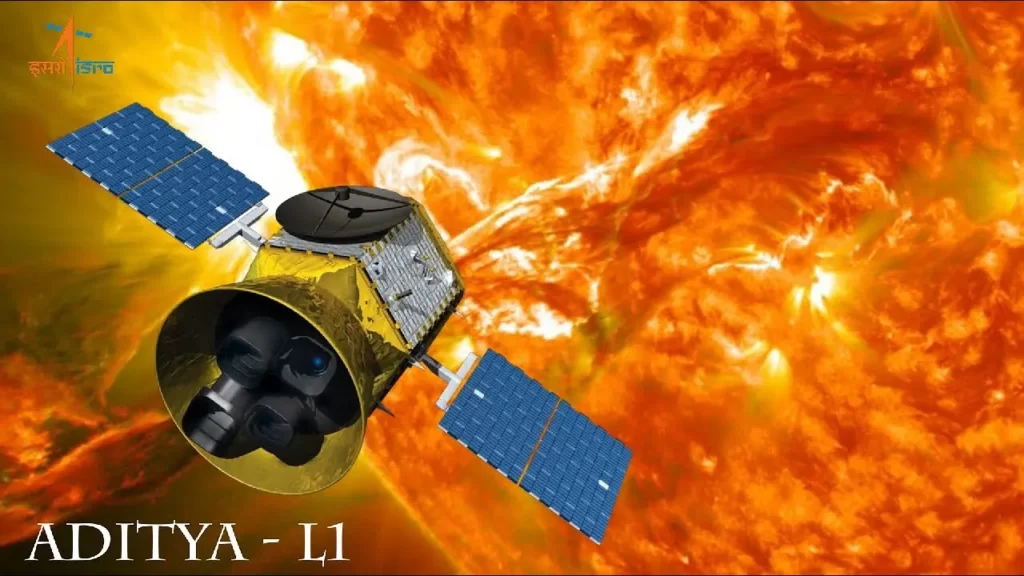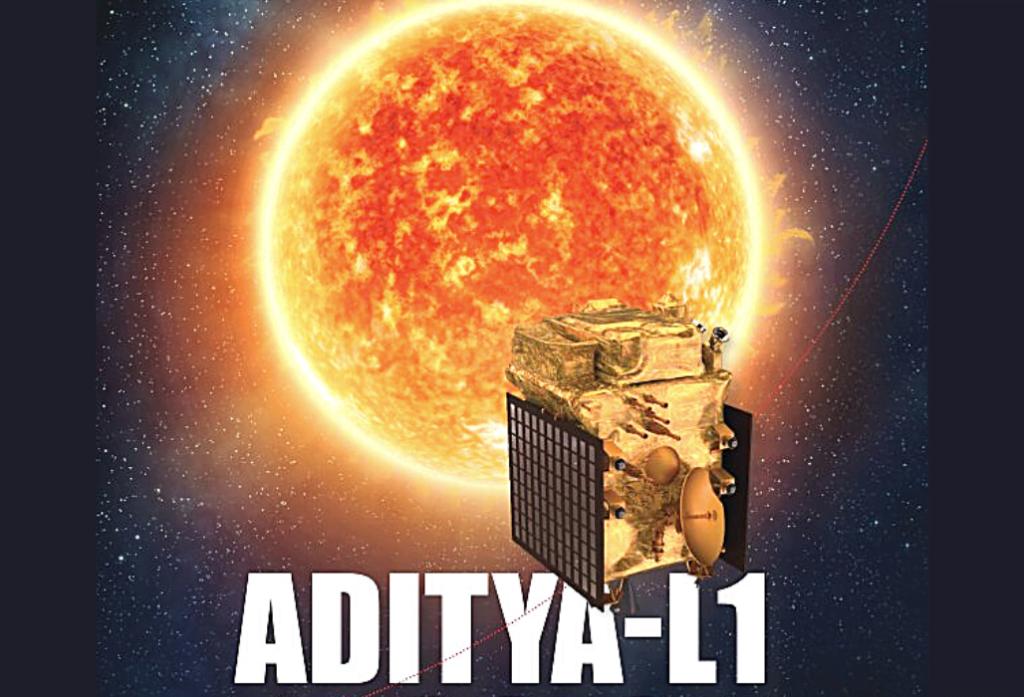India’s New Solar Mission ADITYA-L1: India’s space agency, the Indian Space Research Organisation (ISRO), is set to launch its first solar mission, ADITYA-L1, in August 2023.
The spacecraft will be placed in a halo orbit around the Sun-Earth Lagrange point 1 (L1), which is a gravitationally stable point located about 1.5 million kilometers from Earth.
Table of Contents
India’s New Solar Mission ADITYA-L1
Aditya-L1 is named after Aditya, the Hindu god of the Sun. The spacecraft will carry a payload of seven scientific instruments that will study the Sun’s corona, photosphere, chromosphere, and solar emissions. The mission’s main goals are to:
- Understand the physics of the solar corona, which is the outermost layer of the Sun’s atmosphere
- Study the causes of solar flares and coronal mass ejections (CMEs), which are large expulsions of plasma and magnetic field from the Sun
- Investigate the impact of solar activity on Earth’s space environment
Aditya-L1 is a highly ambitious mission, and it is expected to make significant contributions to our understanding of the Sun.
The mission’s findings will help scientists to better understand the Sun’s role in space weather, which can have a significant impact on Earth’s atmosphere and climate.

The launch of Aditya-L1 is a major milestone for ISRO, and it is a testament to the agency’s growing capabilities in space exploration. The mission is also a significant achievement for India, as it will be the first solar mission to be launched by an Asian country.
The Scientific Instruments on Aditya-L1
The seven scientific instruments on Aditya-L1 are:
- Solar coronagraph: This instrument will image the Sun’s corona in great detail, allowing scientists to study its structure and dynamics.
- Spectrometer: This instrument will measure the Sun’s emissions in different wavelengths of light, providing information about the composition and temperature of the solar atmosphere.
- In-situ magnetometer: This instrument will measure the magnetic field strength at the L1 point, which will help scientists to understand the interaction between the Sun and the Earth’s magnetic field.
- Energetic particle detector: This instrument will measure the flux of energetic particles from the Sun, which can have a significant impact on Earth’s atmosphere.
- Radiometer: This instrument will measure the Sun’s thermal radiation, providing information about its temperature and energy output.
- Plasma analyzer: This instrument will measure the composition and properties of the plasma at the L1 point, which will help scientists to understand the interaction between the Sun and the Earth’s magnetosphere.
- Camera: This instrument will provide images of the Sun in visible and ultraviolet light, which will be used to study the Sun’s surface and atmosphere.

The Benefits of Aditya-L1
The Aditya-L1 mission is expected to provide a wealth of new information about the Sun, which will have a number of benefits.
For example, the mission’s findings will help scientists to better understand the causes of solar flares and CMEs, which can have a significant impact on Earth’s space environment.
The mission’s findings will also help scientists to develop better models of the Sun, which will be used to predict space weather events.
In addition, the Aditya-L1 mission is expected to boost India’s space research capabilities. The mission will provide valuable experience in designing, building, and operating spacecraft that operate in the harsh environment of space. The mission will also help to train a new generation of space scientists and engineers.
The data collected by Aditya-L1 will help scientists to better understand the Sun and its influence on the Earth’s climate and environment. The mission is expected to make significant contributions to our understanding of solar physics and space weather.

The scientific objectives of Aditya-L1
The scientific objectives of Aditya-L1 are to:
- Study the structure and dynamics of the Sun’s atmosphere, including the corona, the chromosphere, and the photosphere.
- Understand the mechanisms that heat the corona and drive solar flares and coronal mass ejections.
- Investigate the relationship between solar activity and space weather.
- Improve our understanding of the Sun’s impact on the Earth’s climate and environment.
The instruments on Aditya-L1
Aditya-L1 is equipped with seven scientific instruments, which are:
- The Solar Coronagraph (SCI) will image the Sun’s corona in high detail.
- The High-Resolution Telescope (HRIT) will image the Sun’s photosphere and chromosphere in high resolution.
- The Extreme Ultraviolet Spectrometer (EUV) will measure the Sun’s extreme ultraviolet emission.
- The Solar Wind Experiment (SWE) will measure the solar wind and its interaction with the Earth’s magnetic field.
- The Magnetometer (MAG) will measure the magnetic field at the L1 point.
- The Particle Detector (PD) will measure the flux of particles from the Sun.
- The Electron Spectrometer (ES) will measure the energy distribution of electrons from the Sun.
The launch of Aditya-L1
Aditya-L1 is scheduled to be launched on August 26, 2023, from the Satish Dhawan Space Centre in Sriharikota, India. The spacecraft will be launched on a Polar Satellite Launch Vehicle (PSLV) rocket.
The significance of Aditya-L1
Aditya-L1 is a significant mission for India’s space program. It is the first solar mission that India has undertaken, and it will provide valuable insights into the Sun and its influence on the Earth.
The data collected by Aditya-L1 will be used by scientists around the world to improve our understanding of solar physics and space weather.
The Future of Aditya-L1
The Aditya-L1 mission is scheduled to last for five years. However, the mission could be extended if the spacecraft is still functioning well after five years. The mission’s data will be made available to the public, and it is expected to be used by scientists around the world to study the Sun and its impact on Earth.

The Aditya-L1 mission is a major milestone for India’s space program, and it is a testament to the agency’s growing capabilities in space exploration.
The mission is also a significant achievement for India, as it will be the first solar mission to be launched by an Asian country.
The mission’s findings are expected to have a significant impact on our understanding of the Sun and its impact on Earth, and they will benefit scientists and engineers around the world.
Friends, You may visit my web story section for more trending entertainment news, and upcoming movie trailers.
You’ll like to read these post
How to Create a GDPR Message on AdSense, Best Ideas in 2023
Top 7 Best AI SEO Tools for Blogging in 2023 to Make it Fast
5 Best Free Video Editing AI Tools for YouTube in 2023, Videos for How to Use
Most Powerful Phone in the World Launched, Watch Unboxing to Know More
World’s top10 best laptop brands ideas in 2023 to select the best laptop for you
American Idol Season 22: New Auditions
9 Of The World’s Prettiest Pink Destinations Like Barbie’s Dreamland
Google and Apple’s New AirTag Alert for Android Users in 2023
Please share this post with your friends